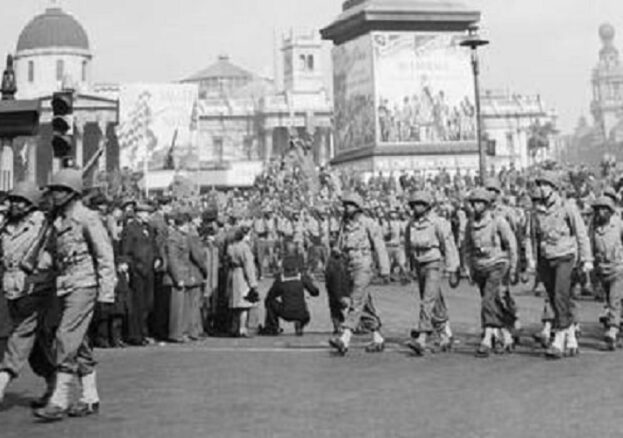
In preparation for the largest amphibious invasion in the history of warfare on 6 June 1944, the American’s brought with them to the UK 1.4 million troops along with nearly 10 million tons of supplies. Included were their K-rations, chewing gum, cigarettes, condoms and railroad ties and tracks that would be required because the Allies were certain to destroy miles of it in France by bombing in the hours before the invasion.
Unfortunately, as the same time, the Americans also brought along their segregation and bigotry against their own Black citizens, referred to as Negros at the time, as well as their so-called ‘Jim Crow Laws’ implemented mainly to enforce racial segregation in the Southern United States. And it wasn’t only casual individual prejudice ingrained over generations – it was the official policy of the United States Armed forces.
There was harsh treatment from prejudice at every level in the US armed forces: Black officer training inequities, unequal transportation of Black troops and savage attitudes towards the Black soldier in general. It went as far as Blacks not being allowed to donate blood for White soldiers. Even blood was segregated.
Mistreatment of Black American servicemen by their White comrades came to a head during a serious incident that took place in June of 1943 between Black and White soldiers in a town called Bamber Bridge in Lancashire, which began because of negative reactions by some White Military Police towards Black soldiers fraternising with local White woman. A violent riot ensued when the MPs attempted to arrest several African American soldiers from their racially segregated regiment at Ye Olde Hob Inn public house, where several soldiers were shot and seriously wounded.
The American commander at the time placed the blame for the violence on the White officers and MPs because of poor leadership and their use of racial slurs.
The English people of Bamber Bridge supported the Black troops, and when US commanders demanded a coloured bar in the town, all three pubs posted “Black Troops Only” signs.
This was not the only incident that boiled the blood of the local English hosts. There were also stories of whole villages in Norfolk being completely segregated, Black and White, and certain establishments being White only or Black only, which incensed the English locals.
The British military authorities tried to push back against these incidents by imposing “Jim Crow segregation” in Britain to please their Americans saviours, but this further steeled the English against complying.
Historian Graham Smith who wrote WHEN JIM CROW MET JOHN BULL: Black American Soldiers in World War II (1987), Britain stated that ‘Blacks were warmly welcomed in Britain, and the action of the white Americans in furthering a colour bar was roundly condemned.”
Roy Ottley, who was among the most famous African American correspondents in the United States during the mid-20th century, working for Negro Digest pointed out that while the British “do draw racial distinctions and are not without racial prejudice, they have it in a form less blunt than US segregationist policies.” And while prejudice “did exist” against American Negros, the main origin was from what the Black troops faced from their Army superiors.
It has been suggested in a paper from Oxford Academic called Shocking Racial Attitudes: Black G.I.s in Europe that the presence of African American soldiers in the UK (David Schindler, Mark Westcott) helped as time went on since the war to actually reduce anti-minority prejudice in the UK, a result of the positive interactions which took place between the soldiers and the local population.” The paper suggests that this change “has been persistent and in locations in where more African American soldiers were posted, there is less implicit bias against black and fewer individuals professing racial prejudice.”
The authors of this study believe that the transmission of these attitudes from parents to children as the most likely explanation.
So there does appear to be some hope.
And while great strides have been made in the last half century, it is still not enough. Great change is still needed, and among the tools certainly are education and proper upbringing directed towards fostering racially neutral attitudes.
Peter Angus is the author of Fabyan Place, an historical fiction novel that portrays two US servicemen, one in the American Quartermaster (supply) Corps and a mixed race Native American, and one in the U.S. 92nd Infantry Division, a light skinned Negro who enlisted for the war effort in Georgia. It details the trials they faced, what they learn about themselves, and the friendship they developed. Some incidents mentioned in this article are portrayed in the novel.
https://academic.oup.com/restud/article/88/1/489/5880000
https://www.nationalww2museum.org/war/articles/world-war-ii-black-quartermasters
https://ilovemanchester.com/why-manchester-abraham-lincoln-statue-square
https://www.suffolkarchives.co.uk/displays-online/black-us-servicemen/racial-tensions/
